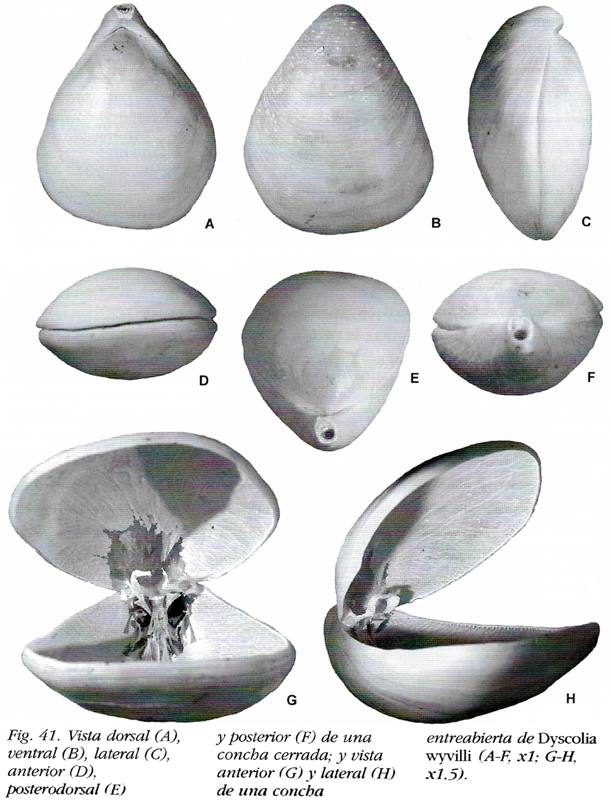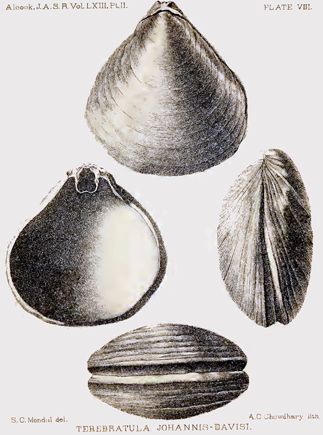 |
|||||
|
Genus Dyscolia Fischer & Œlhlert, 1890 |
| [Type species = Terebratulina wyvillei Davidson, 1878 (p. 436)] |
Medium to very large, subtrigonal to elongate oval; ventribiconvex; surface smooth or with fine, zigzag capillae; beak short, suberect, often truncated or labiate; foramen large, epithyrid to submesothyrid; symphytium almost concealed; pedicle collar long, anteriorly excavated; cardinal process not developed, diductor muscles attached to apical pit; outer hinge plates very weakly developed; crural processes weak, blunt; loop small (less than 0.3 dorsal valve length), thin, with rounded, anterolateral extremities; lophophore small, modified schizolophe; spicules very abundant; four main mantle canals in each valve, branching pattern pinnate. |
| Pliocene - Present
Diagnosis from volume 5 of the
|
| Extant Species of Dyscolia |
|
|
Diagnosis Diagnosis Diagnosis Diagnosis Diagnosis |
|
|
|
D. wyvillei (Davidson, 1878) Type locality: "dredged off Culebra Island, to the north-west of St. Thomas, in the West Indies, at a depth of 390 rathoms". Terebratulina wyvilli Davidson, 1878, p. 436 Diagnosis (Álvarez & Emig, 2005) Concha de tamaño grande (L máx. = 55 mm, A máx. = 45 mm), blanquecina, biconvexa a ventribiconvexa, subpentagonal, superficie externa con capilas radiales finas y líneas de crecimiento concéntricas regulares (A-F). Gancho ventral corto (A, C). Interior de la valva dorsal con un braquidio sencillo, corto, terebratuliforme (G, H); proceso cardinal poco desarrollado al que se le fija la terminación dorsal de los músculos diductores (G). Margen lateral interno de ambas valvas con pequeños tubérculos (G, H). Canales del manto ampliamente ramificados anterolateralmente (G, H).
Facsimile of the Fig. 41 of Álvarez & Emig (2005). Views : A-dorsal ; B-ventral ; C-lateral ; D-anterior; E-postero-dorsal; F-posterior; G-H-open shell. |

|
|
Dyscolia radiata Cooper, 1981 Type locality: st. MD.08: 6, DC 47: 33°11.4'S, 44°00.4'E, Walters Bank, at 620-635 m. Diagnosis (Cooper, 1981) Subtriangular, loop narrow, crural processes obtuse, surface covered by fine irregular capillae. Copper (1981, p. 24) states: “Dyscolia? radiata most resembles Dyscolia ewingi Cooper from off South America in south Atlantic waters. There is also resemblance to Liothyrella? neozelanica.” |
|
|
Dyscolia sp. References and Depth: Foster (1974): 915-1153 m, 1887-1894 m; Foster (1989): 4118 m; Hiller (1994): 680-715; Zezina (1980): 580 m. |
|
|
Dyscolia johannisdavisi (Alcock, 1894) Type locality: "dredged in the Laccadive-Maldive basin, off the island Uliganu of the Northern Maldive atoll, at a depth of 719 fathoms, on a bottom of fine coral sand". Terebratula johannis-davisi Alcock, 1894 Diagnosis (Alcock, 1894) Shell pyriform, inequilateral, thin but strong, its surface smooth except for the concentric lines of growth, and microscopically punctate : in colour purple-brown. The shell is remarkable in being inequilateral, having a well-marked bulge to the left side (the shell being held ventral valve downwards and beak pointing backwards) : and this asymmetry is shown by the lines of growth to have existed from an early period of life. |
 |
|
Dyscolia subquadrata (Jeffreys, 1878) Type locality: "Off the coast of Portugal, in 500-600 fathoms". Terebratula subquadrata Jeffreys, 1878, p. 402. Diagnosis (Álvarez & Emig, 2005) Concha generalmente gruesa de tamaño, medio a grande, blanca, amarillenta o marrón claro, subtrigonal, biconvexa a ventribiconvexa. Superficie externa con líneas de crecimiento concéntricas, regulares, y una ornamentación radial fina, no siempre bien desarrollada (A, J, K). Gancho ventral corto, foramen grande, epitírido a submesotírido (A, B, D, E). Interior de la valva ventral con dientes en forma de gancho y pequeños (B); huellas musculares poco marcadas (B). Interior de la valva dorsal con un braquidio sencillo, que ocupa aproximadamente 1/3 de la longitud de la valva dorsal y 1/4 de su anchura (C, F, B).
Facsimile of the Fig. 60 of Álvarez & Emig (2005). Views : A-dorsal ; B-internal ventral ; C-F-H-internal dorsal ; D-dorsal; E-postero-dorsal; G-anterior; I-lateral; J-K-details. |

|
